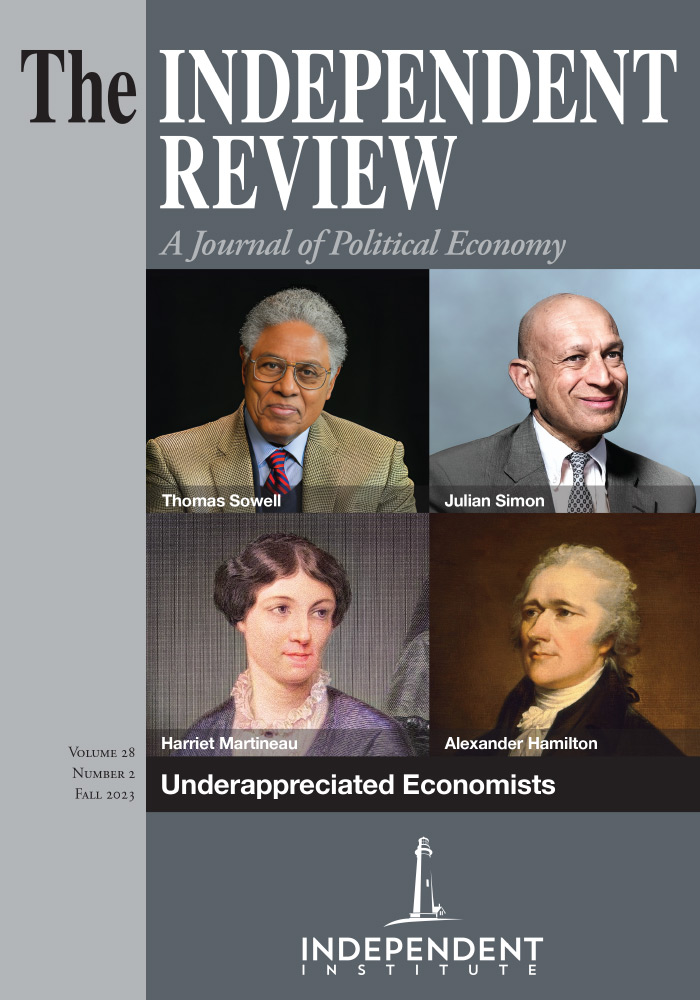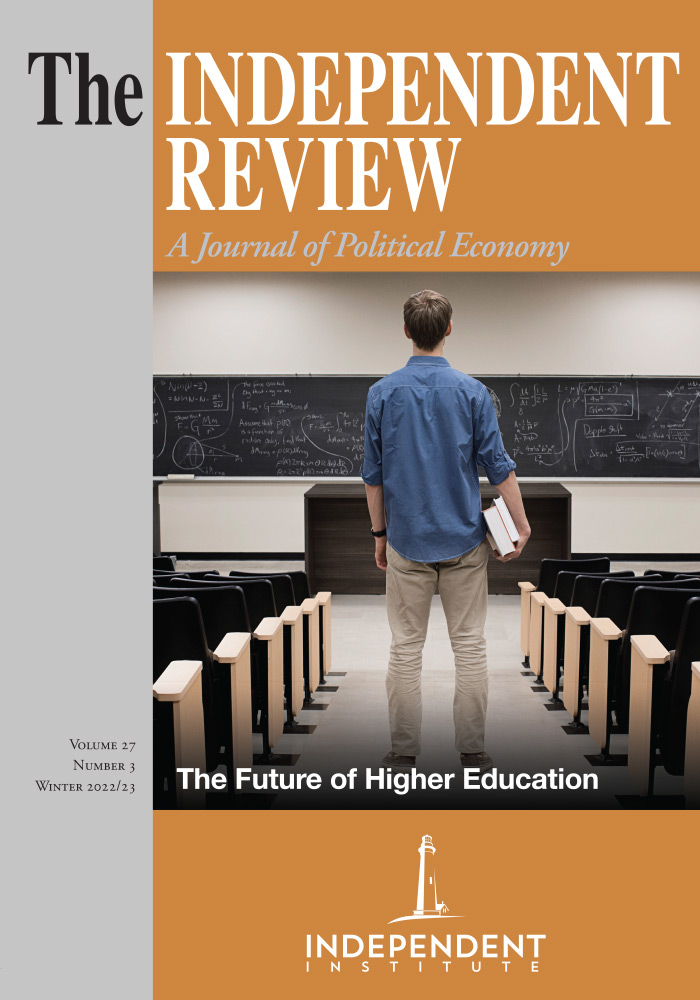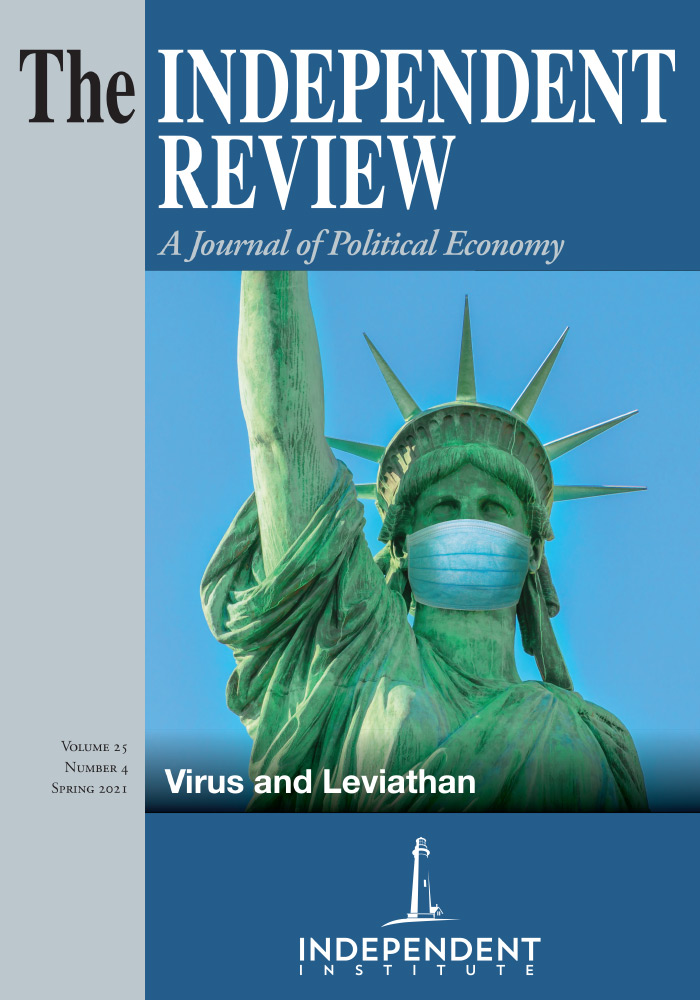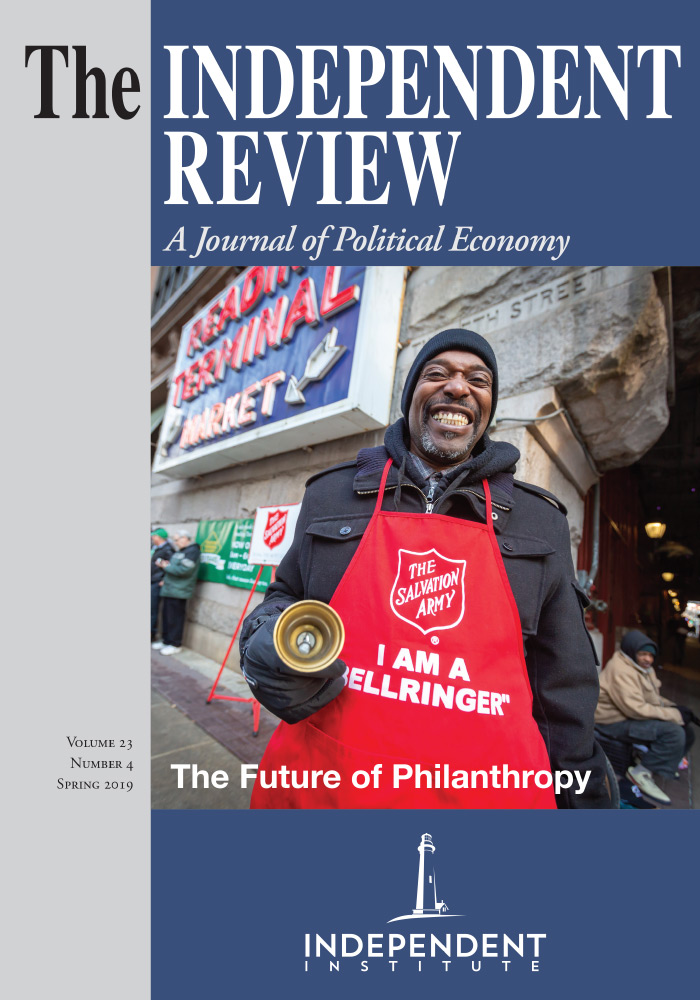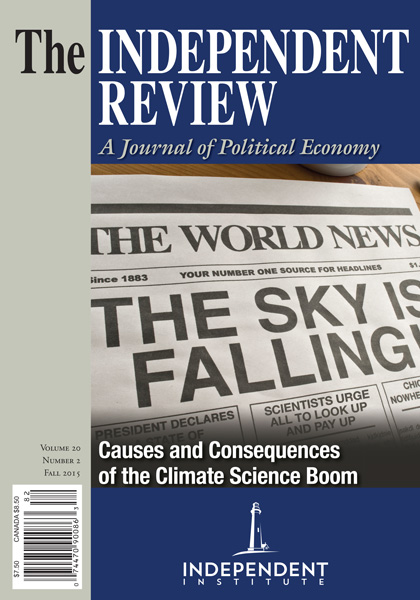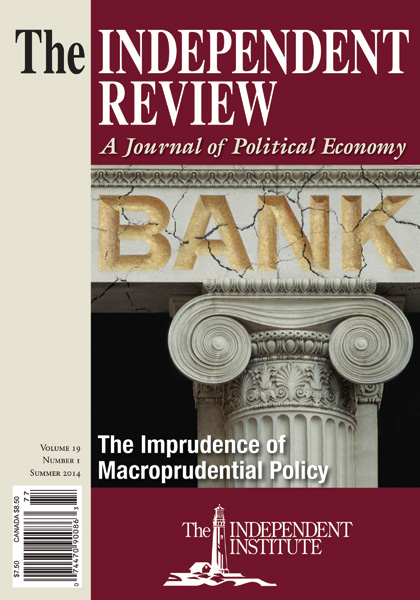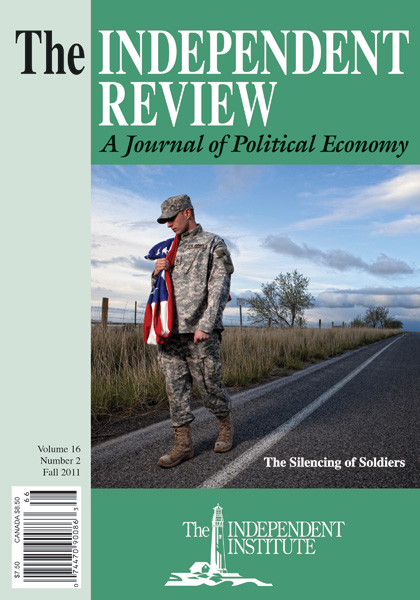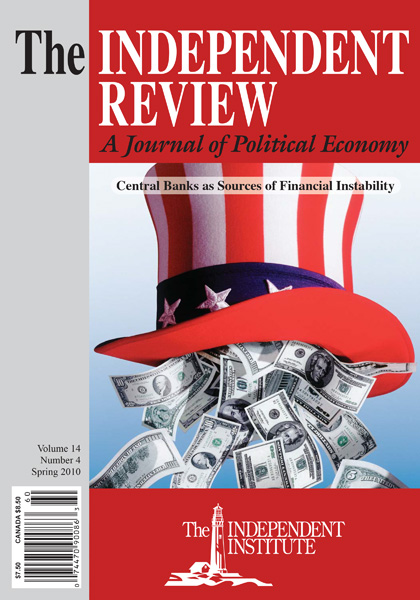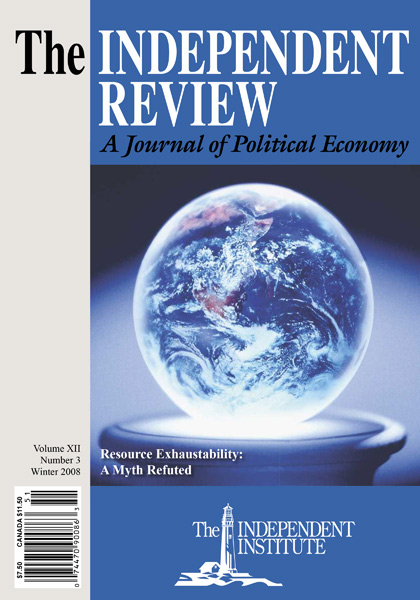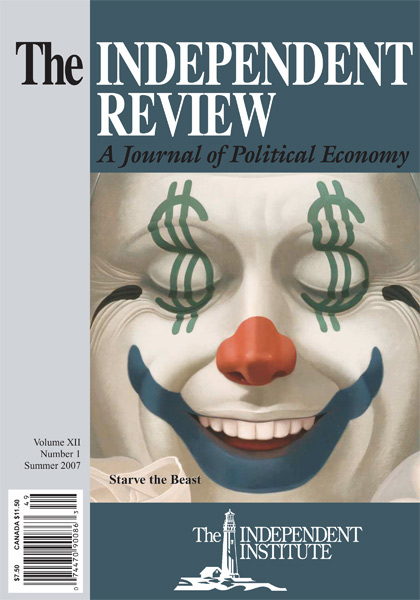This paper was selected by the editors as the winner of the $1,000 third place prize in the 2023 Independent Review Student Essay Contest, which was funded by a grant from the Pope Foundation.
Cantillon’s Essai and Entrepreneurial Theory
While most associate the beginning of modern economic thought with Scottish economist Adam Smith and his 1776 work The Wealth of Nations, fewer have heard of eighteenth-century French economist Richard Cantillon and his important contributions to the discipline of economics. Cantillon’s only surviving work, Essai sur la Nature du Commerce en Général, has rightly gained further study and appreciation in more recent times, particularly for its influence leading to the modern economic thought of the Classical and Austrian schools (Thornton 2007). Breaking with the prior scholastic thinkers’ focus on ethics and the Mercantilists’ emphasis on treasure accumulation and policy, Cantillon’s Essai focused on systematic analysis and theory (Rothbard 1995, 347–48). His Essai,published after his death in 1755, is divided into three books (Jevons 1881, 61–63). Book I of the Essai describes Cantillon’s idea of the overall economy considering society, value, and wages, while Book II explains his monetary theory, and Book III develops his theory of trade and “foreign commerce” (Jevons 1881, 67).
The Physiocrats, such as Marquis de Mirabeau and François Quesnay, mention Cantillon in many of their works, and Adam Smith cited the Essai in Book I of his Wealth of Nations regarding subsistence wages and population (Hayek 1985). After the Physiocrats and Smith, economic discourse failed to consider Cantillon’s work until Stanley Jevons rediscovered it in the late 1800s (Hayek 1985). Jevons argued that the Essai ought to be considered the “cradle of political economy” in an article for the Contemporary Review (Hayek 1985). He believed the book deserved such a title for its systematic insight into the overall economy, monetary theory, population, and limited resources—all of which Cantillon described in a connected, coherent manner (Thornton 2007).
Cantillon’s understanding of the general economy of landlords, farmers, and workers in market towns and cities, as described in Book I, hinges on his theory of the entrepreneur. This actor serves as the risk-taker and efficient allocator of resources in the economy. Cantillon understood that the economy consists of a series of interconnected markets and entrepreneurs—ranging from farmers to merchants—who buy input goods at known prices to sell their finished products in the future for unknown prices (Cantillon 1755, 25). In this way, entrepreneurs become “the catalyst to production and exchange” in coordinating resources in response to given supply and demand in the hope of profit. Such actions form a “circular flow of production income and expenditure” in the economy (Murphy 1986, 6).
How entrepreneurial activity arises in societies depends upon that society’s institutions (Ekelund and Hébert 2014, 56). While the societies of France and England faced the institutional constraints of mercantilist doctrines such as government-regulated guilds and monopolies, Cantillon considered the driving factor of free, enterprising action in economic activity (Rothbard 1995, 216–17). While few previous thinkers had considered the entrepreneur in the same capacity, some approached such conceptions, such as Jacques Savary’s 1675 merchant manual The Perfect Merchant, which describes the merchant as an active economic agent capable of enterprising partnership (Howard 1932, 243). Yet Cantillon understood the concept of entrepreneurship as it is used today even before other economists explored the theory (Brown and Thornton 2013). He even preceded Adam Smith’s conception of the “undertaker’” who invests in capital, such as materials or labor, for the aim of future profit (Smith 1776, 18).
A look into Cantillon’s life and career in the late 1600’s into the early 1700’s in conjugation with Book I of his Essai provides insight into how he developed such an original component of his economic theory. Cantillon’s family history, his social network through his connection with conservative land-owning noble Lord Bolingbroke, and the European financial systems he encountered influenced his support of little intervention in the economy. Such a sentiment consequently formed his conception of the allocation of resources by free agents exemplified in the entrepreneur. Additionally, his work for British Paymaster James Brydges and career as banker and merchant in Paris led to his idea of the entrepreneur as an “uncertainty-bearing” actor who buys at known costs to sell for unknown returns (Rothbard 1995, 351). Through examining Cantillon’s life and influences, one can understand and appreciate the intellectual history behind his conception of the economy and the prevalent role of the coordinating, risk-taking entrepreneur.
Feudal Economy and Family Life
To grasp the basis of Cantillon’s understanding of limited state action in the economy and the importance of the “equilibrating function” perpetuated in the entrepreneur, one must first examine his familial history (Rothbard 1995, 352). Cantillon was born in the 1680 in Kerry County Ireland to a “family of Catholic landlords” in Clanmaurice (Murphy 1986, 17). His family had held the lands for over five centuries (Murphy 1986, 17). In the 1650’s, Oliver Cromwell and his army seized the family’s lands of over 1,500 acres as they had supported the Jacobite cause of the Catholic Stuarts (Murphy 1986, 17). While the family eventually returned to farm and oversee these lands, stories of such a family event would have remained with Cantillon, forming his distrust in centralized authority and his understanding of the importance of land ownership (Murphy 1986, 18).
Growing up in the Irish feudal system also formed his inclusion of the landlord in his economic model. According to Brown and Thornton’s analysis of Cantillon’s entrepreneurship theory, “there are three main actors in Cantillon’s economy,” with property ownership held exclusively by one of these actors: the landlords (2007). The others are the laborers with fixed wages and the entrepreneurs with unset wages, for as Cantillon writes, “only the prince and landlords live independently; all the other classes and inhabitants are hired or are entrepreneurs” (Cantillon 1755, 21). The laborers and entrepreneurs receive their subsistence from the landowner as wealth stems from land and labor, as wealth is “nothing other than food, commodities, and the comforts of life,” according to Cantillon (Cantillon 1755, 3). Cantillon’s upbringing in feudal Ireland formed his understanding of the landlord and private property as central to the economy and his conception of wealth. His wariness regarding state control also helped him to develop a more complex market model. This model featured the entrepreneur with unfixed wages, operating under the landlord’s property ownership, as a guiding economic force amid unpredictable factors. These free agents “proportion themselves in a state to their customers or to their consumption” (Cantillon 1755, 26), similar to Smith’s “invisible hand” coordination concept, as Brown and Thornton point out. Cantillon’s own life experiences helped him to further develop the risk-taking component of this actor as well.
Cantillon as Entrepreneur: Venturing Banker and Merchant
Cantillon’s own career as a risk-taker, banker, and entrepreneur throughout Europe helped form his conception of entrepreneurship as central to handling uncertainty and economic coordination in a decentralized system with property rights. As recorded in Murphy’s biography, Sir William Petty’s account of life in seventeenth-century Ireland in The Political Anatomy of Ireland describes limited economic opportunities for people on the island (Murphy 1986, 19–20). For example, its inhabitants faced strict trade regulations with England, unclear property rights, and limited political representation in Parliament (Murphy 1986, 19–20). In the early 1700s, Cantillon followed many of his other family members in their move to France to become bankers, soldiers, and merchants in the wine or clothing businesses (Murphy 1986, 254). Since those of Cantillon’s background faced the limited career options of tenant farming or smuggling prevalent on the island (Murphy 1986, 120), many Irish left for France to join the military or explore new trades (Murphy 1986, 25).
Going to Paris as a young man with few funds, Cantillon embraced the risk of traveling to a new land and used his family’s connections with the banker Chevalier Richard Cantillon in Paris and another relative, Sir Daniel Arthur, who worked as a banker in London (Murphy 1986, 25–27). Through managing the accounts of war payments during the War of Spanish Succession for such relatives, Cantillon proved his abilities. As a result, Daniel Arthur, who worked with British Paymaster General James Brydges, most likely recommended that Brydges hire Cantillon (Murphy 1986, 29). Thus began the relationship that gave Cantillon vast banking experience and led to valuable connections as he became one of Brydges’s accountants from 1711 to 1713, traveling to locations such as the Iberian Peninsula amid war times to conduct business (Murphy 1986, 33–36).
Historians have discovered more than ninety letters between Cantillon and Brydges from this period, demonstrating Brydges’s trust in Cantillon’s effective negotiation of contracts and skilled accounting for troops and supplies (Murphy 1986, 33). Because of his diligent work, Brydges offered Cantillon a position in his London office after work in Spain had decreased in 1713 (Murphy 1986, 39–42). Cantillon took a risk, turned him down, and returned to financially unstable Paris to begin his career in finance there in 1714 (Murphy 1986, 42). Cantillon’s relationship with Brydges exposed him to the value of hard work and the possibility of controlling one’s own fate through initiative amid the unknowns of the future, reflecting his description of the entrepreneur who operates in “circumstances that are uncertain” (Cantillon 1755, 24).
After working in his cousin Chevalier Richard Cantillon’s bank for fours year, by 1718, Cantillon had opened his own successful banking business (Murphy 1986, 43). Through contact with Lord Carnarvon, a connection through Brydges, Cantillon secured adequate credit to start this business (Murphy 1986, 43). To support the bank at this time of French financial instability, he developed trading networks with Ireland, engaged in wine selling, and conducted fine art dealing, further reflecting his enterprising spirit to support himself and his business (Murphy 1986, 59). He also helped John Law form a team to explore France’s Louisiana territory for tobacco and minerals and to establish trading posts, designating his brother Bernard Cantillon to lead the venture in 1719 (Murphy 1986, 93–95). Cantillon’s own diverse career beginning as an accountant and entrepreneur in Paris also formed his idea of the entrepreneur as occupying a vast array of occupations, each with its own inherent risks. For example, he argued that farmers ought to be considered entrepreneurs, as they know the fixed cost of the land but have to rely on their own discretion as well because the market price of their goods is “partially dependent on the seasons and [would] primarily depend on consumption” (Cantillon 1755, 24).
Cantillon went on to list entrepreneurs such as “wool and cereal wholesalers, bakers, butchers, manufacturers, and merchants” in the market towns, according to the needs of the inhabitants (Cantillon 1755, 25). Such a description reflects the diversity of entrepreneurial roles and their prevalent place in the economic flow. Cantillon also wrote about “entrepreneurs of their own labor who do not need money to establish themselves, such as journeymen craftsmen, coppersmiths, needlewomen, [and] chimney sweeps,” who begin without capital but hold an understanding of where a need or misalignment of information in the market arises (Cantillon 1755, 26). Such a conception of the “pure and penniless entrepreneur” would be explored by Austrian thinkers like Israel Kirzner centuries later (Hayek 1985). Kirzner emphasized an “alertness to information” necessary for any entrepreneurial actor in the economy, whether or not he owned capital (Kirzner 1973, 72). Similar to Cantillon’s three actors, Kirzner considered three types of individuals to describe the entrepreneur’s role in the economy. He described price-taking resource owners and consumers, and then entrepreneurial producers who discover opportunities for profit in the market (Kirzner 1973, 18). Kirzner argued that such producers “need not own any resources in order to engage in production”; they just need to know what services could be of value and respond to the information the economy gives (Kirzner 1973, 19). Through an understanding of Cantillon’s early career beginning with his work for Paymaster Brydges and eventual multifaceted occupation as an entrepreneurial bank owner and merchant, one can see the basis for his understanding of the entrepreneur’s role among unknowns and the wide range of markets he fills and coordinates. Cantillon’s friendship with Lord Bolingbroke early in his career and his later involvement in John Law’s system also formed Cantillon’s entrepreneurial understanding, particularly regarding monetary policy and risky speculation.
Lord Bolingbroke and Government Regulation
While Cantillon’s upbringing in the feudal system of Ireland certainly formed his conception of his economic model and land ownership, so did his friendship with conservative land-owning noble Lord Bolingbroke. Bolingbroke served as a leader of the Tory Party in England but fled the nation for France in 1715 after the rise of the Whig Party under George I in 1714. Cantillon, an emerging banker in Paris, handled Bolingbroke’s escape payments with secrecy, and they became friends after meeting. Bolingbroke introduced him to influential figures of the time who supported less despotic monarchies and more individual freedom, such as Montesquieu and Voltaire (Thornton 2007). Yet Bolingbroke himself maintained a conservative emphasis on the landowning gentry class as the “source of natural leadership for rational men” opposing liberal Lockean ideals (Kramnick 1968, 102–3).
Bolingbroke also criticized the new fortunes of the emerging banker and tax-collecting groups of the 1690s in England, exemplified in firms such as the South Sea Company and East India Company (Kramnick 1968, 43–45). He believed these firms’ “materialistic concern with money and luxury expenditure ... did not generate real wealth,” so the upper landowning class had to cover the high national debts and war expenditures through taxes (Murphy 1886, 49). While Cantillon met Bolingbroke early in his career, Bolingbroke’s ideas about the downfalls of speculative economic action and conservative approach concerning the control of landowners likely contributed to Cantillon’s wariness regarding the schemes of John Law that he would later experience in France. These understandings of the limits of government intervention and importance of real wealth stemming from land and labor would help open the door for Cantillon’s entrepreneur.
European Finances and John Law’s System
During his career as a banker in France, Cantillon witnessed the corruption and financial ruin pervasive throughout the French economy in the early 1700s, which led him to a distrust of aristocratic, centralized fiscal policy. Under the reign of King Louis XIV, “extravagant expenditure and bellicosity had virtually bankrupted the state” with France’s engagement in the War of the Spanish Succession (Murphy 1986, 43) and the exodus of persecuted Protestant Huguenot skilled workers (Rothbard 1995, 216). The policies of the king’s finance minister, Jean-Baptiste Colbert, which included quality standards, highly subsidized luxury goods, and taxes that burdened the poor working classes, also perpetuated France’s stifling economic conditions (Rothbard 1995, 218–20).
Such circumstances of internal inefficiency allowed innovators with aristocratic connections to explore new economic policies, take risks, and even make fortunes. John Law’s Mississippi System became the most prominent of these financial ventures, and Cantillon eventually became involved. Establishing himself as the controller general of finances, Law believed that increasing the money supply would stimulate economic activity and decrease unemployment by lowering interest rates. He established the Banque Général in 1716 as the sole provider of paper notes (Rothbard 1995, 330–31). Such control over the first central bank and printing of currency allowed Law in 1718 to establish his Mississippi Company, which merged with the bank in 1720 (Velde 2007, 277). Law backed the central bank’s currency with the nominal value of land as his Mississippi Company received the exclusive right to the Louisiana territory from the government (Rothbard 1995, 331). In return, the company converted the government’s debt into “shares at a lower interest rate,” fueling speculation and high demand for the shares (Rothbard 1995, 331).
In May 1718, Cantillon began corresponding with Law, understanding him to be a successful enterpriser who could help him make a fortune (Murphy 1986, 73). Cantillon impressed Law with his understanding of his monetary system, became one of his partners, and made “the first part of his Mississippi fortune speculating in shares and options of the Company during the summer of 1719” (Murphy 1986, 75). With the market price for shares rising from 500 livres in May 1719 to 10,000 in late December 1719 (Velde 2007, 277), this period of stock booms in France became the first time in history that the term millionaire became common for those who made such fortunes (Rothbard 1995, 331). Cantillon, rising from humble beginnings, joined such a class in a matter of months through his partnership with Law (Jevons 1881, 63).
Other speculators at the time witnessed Cantillon’s early success. Among these was Robert Arbuthnot, an agent of Britain’s South Sea Company, which mirrored the French Mississippi Company but instead was chartered by Parliament for the exploration of South America (Murphy 1986, 158). Arbuthnot wrote in a letter in the fall of 1719, “Young Cantillon has been one of those happy adventurers that have got prodigious fortunes from [the company’s] stocks,” as Murphy details in Cantillon’s biography (1986, 76). While Law’s system helped him make a fortune, Cantillon also understood the shortcomings of Law’s endogenous, endless money supply and the resulting rapid inflation and burst of the speculation bubble. Cantillon left France for Italy and sold most of his shares in late 1719, anticipating the collapse of the system (Murphy 1986, 125–27). He eventually returned to Paris in 1720 and bought into the Mississippi and South Sea Company shares early to make another fortune but sold them before the stock market crashes, as he understood the flaws of such schemes for prolonged economic stimulation (Murphy 1986, 188). While Cantillon spent the final years of his life in London involved in legal disputes over his speculative fortunes, he also took the time to craft his treatise on economics. He died in 1734, likely murdered by his servants in a fire they set to his home, ending his exciting, varied life of travel, investment, and entrepreneurship with tragedy (Hayek, 1985).
Cantillon’s Intellectual History and Its Implications for Entrepreneurship
An analysis of Cantillon’s family history, the formation of his banking and merchant career, his friendship with Lord Bolingbroke, and the financial phenomena of Europe develops an intellectual history of Cantillon’s unprecedented theory regarding free market activity and the function of the entrepreneur. Such agents respond to market supply and demand, establishing proper prices for goods and labor amid competition and unknown future events (Rothbard 1995, 360). While his idea of the entrepreneur is broadly defined as emerging from a feudal economy under landlords, Cantillon’s conception of this actor holding a major role in market coordination would be developed by French economist Jean-Baptiste Say over a century later. Say emphasized the entrepreneur’s role in innovation amid competition (Boutillier and Uzunidis, 2014). Later, other economists such as Carl Menger and those of the Austrian school, such as Ludwig von Mises, Friedrich Hayek, and Israel Kirzner, would develop similar entrepreneurial theories (Boutillier and Uzunidis, 2014). For example, in his work Human Action, Mises asserted that the entrepreneur is more than a profession or class, but rather serves a pervasive economic function (Hébert 1985, 273). He wrote that “the economic term ‘entrepreneur’ is a precisely defined concept which in the framework of a theory of market economy signifies a clearly integrated function” that transcends class, business, and geographical distinctions (Mises 1998, 253). Because every human action involves uncertainty, Mises understood entrepreneurship to be inherent in all classes from landowners to laborers.
Additionally, Kirzner echoed a sentiment similar to Cantillon’s in his discussion of the “equilibrating” entrepreneur in refuting Joseph Schumpeter’s view expanding on the Walrasian model, which assumed perfect conditions (Boutillier and Uzunidis, 2014). Schumpeter argued that the entrepreneur “disrupts the continuing circular flow” of the market by making new discoveries or systematic changes (Kirzner 1973, 72). In response, Kirzner wrote, “The changes the entrepreneur initiates are always towards the hypothetical state of equilibrium,” and such changes adjust “those discordant elements which resulted from prior ignorance,” reinforcing Cantillon’s ordering capacity of the entrepreneur (Kirzner 1973, 73). But how do economists understand entrepreneurship today? Most often disregard the entrepreneur in their theories because such an actor is unquantifiable in models and formulas, and it is difficult to concretely determine elements such as supply and demand for entrepreneurship (Baumol 1968, 70). Yet modern economists ought to recognize the entrepreneur’s major role in coordination and economic growth conducive to progress that Cantillon clearly understood (Baumol 1968, 66–70). In doing so, societies will understand the importance of establishing institutions that encourage entrepreneurship in all its forms, and economics will actually reflect the “dynamic nature of the world” that Cantillon lived out so vividly throughout his own career, centuries ago (Brown and Thornton, 2013).
References
Baumol, William J. 1968. “Entrepreneurship in Economic Theory.” American Economic Review 58, no. 2: 64–71.
Boutillier, Sophie, and Dimitri Uzunidis. 2014. “The Theory of the Entrepreneur: From Heroic to Socialized Entrepreneurship.” Journal of Innovation Economics and Management, no. 4: 9–40.
Brown, Christopher, and Mark Thornton. 2013. “How Entrepreneurship Theory Created Economics.” Quarterly Journal of Austrian Economics 16, no. 4 (Winter): 401–20.
Cantillon, Richard. [1755] 2015. Essay on the Nature of Trade in General. Translated by Antoin E. Murphy. Indianapolis, IN: Liberty Fund Press.
Ekelund, Robert B. Jr., and Robert F. Hébert. 2014. A History of Economic Theory and Method. 6th Edition. Long Grove, IL: Waveland Press, Inc.
Hayek, Friedrich A. Fall 1985. “Richard Cantillon: An Introduction.” Translated by Micheál Ó Súilleabháin. Journal of Libertarian Studies 7, no. 2 (Fall): 217–47.
Hébert, Robert. 1985. “Was Richard Cantillon an Austrian Economist?” Journal of Libertarian Studies 7, no. 2 (Fall): 269–79.
Howard, Stanley E. 1932. “Business Partnerships in France Before 1807.” Accounting Review, vol. 7 no. 4 (December): 242–57.
Jevons, Stanley. 1881. “Richard Cantillon and the Nationality of Political Economy.” Contemporary Review 39 (January): 61–80.
Kirzner, Israel M. 1973. Competition and Entrepreneurship. Chicago, IL, and London, UK: University of Chicago Press.
Kramnick, Isaac. 1968. Bolingbroke and His Circle: The Politics of Nostalgia in the Age of Walpole. Cambridge, MA: Harvard University Press.
Mises, Ludwig von. 1998. Human Action: A Treatise on Economics. Auburn, AL: Ludwig von Mises Institute Press.
Murphy, Antoin E. 1986. Richard Cantillon: Entrepreneur and Economist. Oxford: Clarendon Press.
Rothbard, Murray N. 1995. Economic Thought Before Adam Smith: An Austrian Perspective on the History of Economic Thought, Vol. I. Brookfield, VT: Edward Elgar Publishing Company.
Thornton, Mark. 2007. “The Origin of Economic Theory: A Portrait of Richard Cantillon (1680–1734).” Mises Institute. https://mises.org/library/biography-richard-cantillon-1680-1734.
Velde, Francois R. 2007. “John Law’s System.” American Economic Review 97, no. 2 (May): 276–79.




